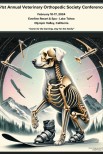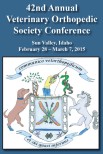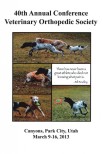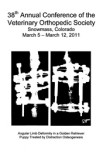Objectives: To describe a surgical stabilization technique and immediate postoperative care for traumatic lateral shoulder luxation in a dog as well as report long-term clinical outcome.
Animals: One dog.
Study design: Case report.
Methods: Following failed closed reduction, the surgical stabilization of traumatic, acute, lateral shoulder luxation included three, figure-of-eight 40 # fluorocarbon sutures. On one end, all three sutures were passed through a 2.7 mm screw anchor placed in the scapula neck, craniodistal to the acromion. The free ends of two sutures were passed through two drilled bone tunnels in the greater tubercule. The third figure-of-eight suture was looped around a 2.7 mm cortical screw and washer placed in the caudolateral aspect of the humeral metaphysis. A spica splint was placed and maintained for 4 weeks postoperatively and changed weekly.
Results: There were no major nor minor complications within the 9 months follow-up. By 6 weeks, only mild grade 1/5 lameness was reported on orthopedic examination. At the last two rechecks at 19 and 40 weeks postoperatively, orthopedic examination revealed minimally decreased shoulder flexion and extension with pain-free range of motion (ROM) and no clinical lameness.
Conclusion: The novel surgical stabilization technique described in this report to address lateral shoulder luxation in a dog is technically straightforward and, in our case, provided good, lameness-free clinical outcome.









